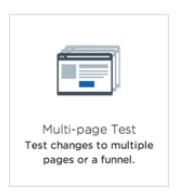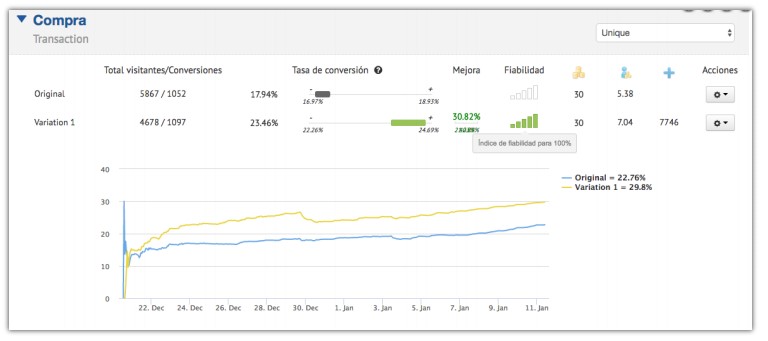Analysis phase (CRO audit)
We analyze the content, design, offer and usability of your website to detect continuous improvement in business profitability
CRO (Conversion Rate Optimization) is a discipline and methodology oriented to the continuous improvement of conversion rates, commercial and business efficiency in our campaigns through the analysis of the user experience and its points of improvement.
If the conversion rate of a website is 2%, through CRO we will try to understand what is happening in the remaining 98% in order to provide valid solutions supported by data to implement.
What are we going to convert: sales, downloads, registrations, calls, chats…
Which ratios are improved: conversion rate, average order amount, number of products, purchase frequency, cost savings by validating ideas…
Which parts are optimized: home page, landing pages, product page, payment process, blog, newsletter, APP… practically EVERYTHING.
Let’s start with these phrases that support this discipline:
The methodology for CRO consultants guarantees that we will be able to approach things in an optimal way. If it doesn’t work, it will teach us to pay attention to it. We must assume that we are going to make a mistake. The good thing is to realize this and to propose a new way to find the correct solution.
Analysis phase (CRO audit)
We analyze the content, design, offer and usability of your website to detect continuous improvement in business profitability
Hypothesis and priorities:
Roadmap of experiments, priority matrix (impact/effort), copy of our contents. In addition we apply the Buyer person and implement the real value proposition for our potential customers.
Test
Depending on the project and experiment we will apply different types of test: A/B, multivariate, split test or multipage.
Results
Each experiment will give us a type of result: negative, neutral or positive. The goal is to find the maximum number of positive experiments possible
We try to make this phase as objective as possible. As a CRO consultant we need to find things that are “improvable” (trying to figure out why).
In this process, we can find enemies within the company, who go against us by being responsible for everything “improvable”. To avoid that, we focus on relying on data and tools that support each and every thing we try to improve or bring to light. We can work in three areas:
Convene a workshop to understand each other first (understanding the company’s business model).
The more information about the company, the more things we can detect on how to make money and before that we will be able to detect the specific things that will generate a greater impact on results. We need to know how everything works, even, most of the time better than the people working in the company itself.
We must carry out an analysis of the client’s business to understand their digital model -> What objectives they want to achieve.
We must have a digital analysis tool correctly configured, since it will be our starting point to obtain information.

Source: cardinalpath.com
From here we will begin to understand what happens on the website, if the investment in traffic they make is profitable. At the same time, we can make segmented conversion funnels where we can detect leakage points.
What does the user do on my website?
After data analysis…
Tools: hotjar, crazyegg…
Heat maps (where users move, can give us information of areas of greater or lesser interest)
Click maps (where users click)
There are many techniques to improve in CRO consulting.
A complete analysis requires a proper understanding of the business, available quantitative data and the behavior of customers or potential customers.
Everything we get out of this phase must be 100% objective.
This is the first subjective phase. Some things that can be improved have already been detected, and someone must fix them.
Any proposal is welcome. We will then validate whether it works or not, but we should not rule out anything at the outset.
Open mind.
CRO consultants must list everything that they can think of, indicating:

From the start in a site, we can get relatively fast 80-90 points to test.
Now let’s see how we establish those priorities in the roadmap.
The priority matrix is a tool that allows the selection of options based on the weighting and application of criteria, in our case:

From this, we extract 4 zones:
We always start with the Quick wins to gain, in addition, the confidence of the client. At the same time, we have to start up Majors projects. As soon as we start some Majors projects, we must also parallelize some Fills ins, to get some quick things out.
Of each solution proposed, we must assess whether it is better or worse than what we have proposed.
Many tests can give neutral or negative results. If most of them are like that, we must know how to identify why (through KPIs) and turn the tests around to propose them again once modified taking into account all that data.
There are many projects that recognize these two facts:
What happens in the middle of this very long process? They don’t know.
This is where we can start testing. Experiment. If at this point, we skip all the previous steps… we will agree that the probability of failure is exponential.




These are the tools within our specialty of CRO consultant that we use the most.
Let’s see an example of A/B testing, where we can see how much traffic the experiment has got, how many people it has converted, and what the conversion rate is.
The conversion is always relative data, it is not of the complete website, but simply of the area that we are analyzing.
Improving the conversion is always done little by little, it is not usually a matter of very large percentages, but it is noticeable in the accumulated positive tests.
Reliability of a test: depending on the traffic you have had, the time of the experiment and how constant it is. There are experiments that never become reliable, we must decide when to stop them (neutral test). Some payment tools give us a degree of reliability, although it is always better to analyze the trend and decide for ourselves.

Graph: evolution of the original and new conversion %. As we see, the difference remains, so it is clear that it is reliable, since it remains without an overlap from the first moment.
The overlap is not always be due to the fact that the change does not work, but to external factors such as the price of our competition at that particular time. We must know how long to wait and give the test a chance before stopping it hastily.

We must implement a clear methodology for analyzing results.
It is advisable to hire a CRO consultant for projects that already have a certain volume of traffic. And from here, the worse they get, the better it is to turn CRO actions into vital needs of the project.
If they also have little capacity to invest more in channels such as Adwords, they become the perfect project.
Nowadays, CRO is an area full of possibilities in all types of companies. For small sites (1000 – 5000 visits per month) we can do things, but they will take many months to give us results, or we will have to take more risks to make decisions that are not 100% verified.
A CRO project appears after a need to improve business objectives. For an active project to improve its sales, we have 2 possibilities:
SEO campaigns, PPC… that improve traffic, and therefore the benefit of the project.

Problem: to make it easier, let’s imagine that we improve traffic with PPC traffic to 0.5 / click (on average and that will be different according to the business, in many instances much higher).
0.5 Euro x 500,000 visits = 250,000

We spent an extra 250,000 euros to make a profit of 50,000 euros, i.e. we lost 200,000 euros of profit straightaway.
We will manage to improve the conversion rate by half a point (to 1.5%). What happens? No extra investment…

With this, we can clearly see that it is not only useful to sell more. It is vital to always have the profitability of the project present.
How are tests usually performed on most websites?
Probability of success: 10%.
Most of the time, the tests are done based on wrong premises, testing things like:
Are we sure we need to make any changes like that on our website? Maybe that’s not what’s working particularly for us. Let’s experiment… but carefully.
Probability of success: 77%.
To detect these tests, it is essential to implement a professional methodology, which we base on 4 steps.
As a cross-cutting discipline, the CRO team generally consists of:
Therefore, we could say something like CRO = web analytics + UX and AI + user voice + market research + copywriting.
1. What is CRO?
2. CRO methodology
3. When to do CRO? Example
4. How can we help you grow?
Puedes ver esta página en español
Consultor CRO